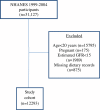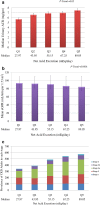Dietary acid load and chronic kidney disease among adults in the United States
- PMID: 25151260
- PMCID: PMC4151375
- DOI: 10.1186/1471-2369-15-137
Dietary acid load and chronic kidney disease among adults in the United States
Abstract
Background: Diet can markedly affect acid-base status and it significantly influences chronic kidney disease (CKD) and its progression. The relationship of dietary acid load (DAL) and CKD has not been assessed on a population level. We examined the association of estimated net acid excretion (NAE(es)) with CKD; and socio-demographic and clinical correlates of NAE(es).
Methods: Among 12,293 U.S. adult participants aged >20 years in the National Health and Nutrition Examination Survey 1999-2004, we assessed dietary acid by estimating NAE(es) from nutrient intake and body surface area; kidney damage by albuminuria; and kidney dysfunction by eGFR < 60 ml/min/1.73 m(2) using the MDRD equation. We tested the association of NAE(es) with participant characteristics using median regression; while for albuminuria, eGFR, and stages of CKD we used logistic regression.
Results: Median regression results (β per quintile) indicated that adults aged 40-60 years (β [95% CI] = 3.1 [0.3-5.8]), poverty (β [95% CI] = 7.1 [4.01-10.22]), black race (β [95% CI] = 13.8 [10.8-16.8]), and male sex (β [95% CI] = 3.0 [0.7- 5.2]) were significantly associated with an increasing level of NAE(es). Higher levels of NAE(es) compared with lower levels were associated with greater odds of albuminuria (OR [95% CI] = 1.57 [1.20-2.05]). We observed a trend toward greater NAE(es) being associated with higher risk of low eGFR, which persisted after adjustment for confounders.
Conclusion: Higher NAE(es) is associated with albuminuria and low eGFR, and socio-demographic risk factors for CKD are associated with higher levels of NAE(es). DAL may be an important target for future interventions in populations at high risk for CKD.
Figures




References
-
- Remer T, Manz F. Estimation of the renal acid excretion by adults consuming diets containing variable amounts of protein. Am J Clin Nutr. 1994;59:1356–1361. - PubMed
-
- Frassetto LA, Todd KM, Morris RC Jr, Sebastian A. Estimation of net endogeneous noncarbonic acid production in humans from diet potassium and protein contents. Am J Clin Nutr. 1998;68:576–583. - PubMed
-
- Remer T. Influence of diet on acid-base balance. Semin Dial. 2000;13:221–226. - PubMed
Publication types
MeSH terms
Grants and funding
LinkOut - more resources
Full Text Sources
Other Literature Sources
Medical
Research Materials
Miscellaneous

